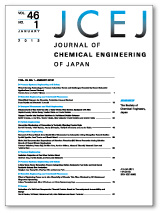Kazuko Yamashita
(The Society of Chemical Engineers, Japan (SCEJ))


The Journal of Chemical Engineering of Japan (JCEJ) was designated as a SPARC Japan partner journal in 2003. It was about the time when we were discussing to develop a new business model for JCEJ as an electronic journal.
● Publication of an English version handbook
The editorial board of JCEJ published “A Handbook for Contributors to the Journal of Chemical Engineering of Japan” to improve the quality of articles in 2003. Analyzing reviewer reports over several years, the handbook, 20-page-or-so, introduces some of the typical defects pointed out during peer review and explains proper phrases and expressions for use in research papers.
The guidebook was available only in Japanese in 2003, and then we published an English version handbook in 2004 thanks to assistance from SPARC Japan. We started to delete the sections exclusively for Japanese authors such as those explaining the handling and romanization of Japanese terms, and added new information to prepare the source text for translation into English. We had the right person for this task: a British researcher formerly specialized in chemical engineering but currently majoring in English communication at a Japanese university. We asked to review the translated text to three researchers, and they gave us many advices about the contents and presentations. We have been receiving favorable feedback from users.
● A proposal for a university library consortium
Another major gain is that we have been able to learn about the activity of university libraries through interactive meetings organized by SPARC Japan.
In 2008, we changed the subscription model of JCEJ from printed version to electronic journal. We had to grow the number of the subscriptions of libraries to increase accesses and citations. With the help of SPARC Japan and a university library consortiums, the Society of Chemical Engineers, Japan (SCEJ) was able to propose its three journals as a package to the consortiums for the first time in 2010. Back then, I did not even know how to write a proposal but persons in charge at the consortiums (currently serving as staffs at the Secretariat of the Japan Alliance of University Library Consortia for E-Resources (JUSTICE)) helped me, providing detailed instructions. I would like to take this opportunity to express my most sincere thanks for them.
I have also had an opportunity to participate in presentation meeting on consortium proposal. I learned many things including tips and ideas for booth setup and last-minute fine-tuning of the presentation by many commercial publishers at the meeting.
Since the SCEJ does not have its own banner for display or tablecloths to decorate the booth, SPARC Japan kindly permitted us to use all necessary items. Most of the non-profit publishers that are currently making proposals for the consortium are publishers of SPARC Japan partner journals.
● Joint promotion of chemistry journals
Joint promotion activities for chemistry journals, launched in 2007, could not have been continued without assistance from SPARC Japan. It would have been difficult for academic societies to send their journal staff to overseas conferences to introduce Japanese chemistry journals if they were to bear the entire cost on their own. However, more than half of the cost was provided by SPARC Japan.
In August 2012, I attended the autumn meeting of the American Chemical Society as exhibition booth staff. We had sent a total of 300 copies of leaflet introducing 11 participating journals to be distributed over three days. As it turned out, however, we had so many visitors at our booth that we ran out of the copies by the evening of the second day. While many overseas researchers show interest in Japanese journals, it is difficult to submit to the journals soon. It made me realize the need to explore ways to turn their interest into concrete action such as submission and subscription.
Under the limited budget, we participated in conferences in three locations—i.e., Asia, North America, and Europe—in each year of the joint promotion program, whereby exhibition booth staff promoted Japanese chemistry journals to overseas researchers by utilizing limited resources. These are the activities that could not have been continued without motivation. In2012, however, it was the last year of the assistance from SPARC Japan to the activities.
● Expectations for SPARC Japan
Back in 2003, we had no idea to develop a new business model for electronic journal. Today in 2013, I find that the business models are getting complicated. It is SPARC Japan that gave me an opportunity, through seminars and other occasions, to learn new forms of publishing and new business models. I continue to expect a lot from SPARC Japan activities.
|

